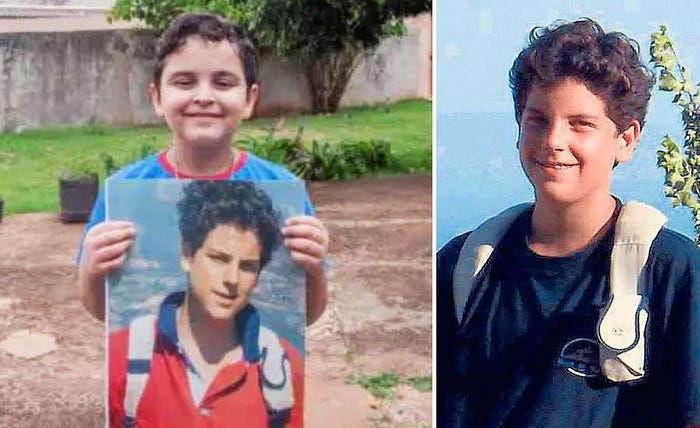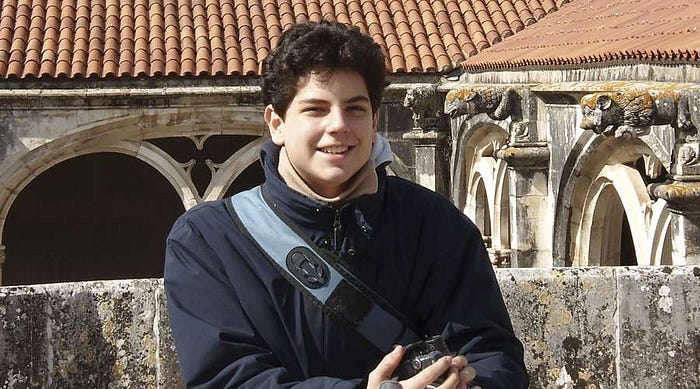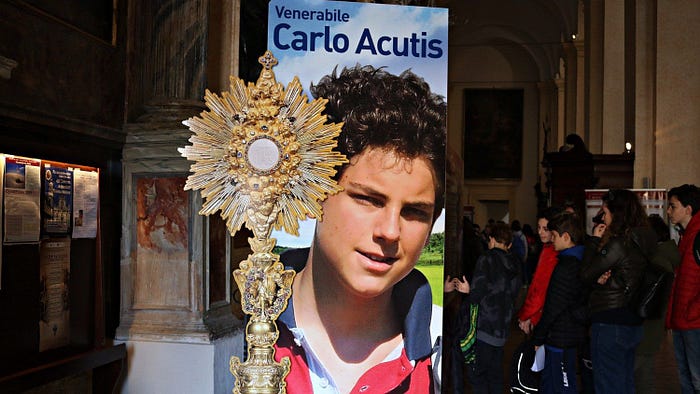From cyberapostol to adolescent saint: The extraordinary case of Carlo Acutis
Last February, Pope Francis announced that Carlo was proclaimed venerable by the Catholic Church, after approving a miracle attributed to him that allows his beatification

It took just over 15 years for Carlo Acutis to demonstrate in life his commitment to the most impoverished, to his spirituality and to his faith. Acutis was an Italian Catholic teenager, student, programmer, music and football lover
Acutis was born on May 3, 1991 in London, England, where his parents, Andrea Acutis and Antonia Salzano, worked. However, when he was six months old, his parents decided to return to their native Italy, to Milan, reports the Catholic News Agency (ACN).
Carlo’s life would extend until his teens, just over 15 years, exactly until October 12, 2006. That year he died of chronic myeloid leukemia while he was in a hospital in the city of Monza.
Last February, Pope Francis announced that Carlo was proclaimed venerable by the Catholic Church. This, after approving a miracle attributed to him that allows his beatification, that is, his qualification as a Saint. Everything will be made official next Saturday, October 10, 2020.
The beatification process includes the exhumation of his body. Days ago, his tomb was opened in a ceremony at the Sanctuary of Dispossession (Santuario de la Expoliación) in Assisi, where he decided that his remains would rest.
The tomb was opened with the presence of different media. It was there that it was observed how Carlo’s body, after 14 years of being buried, remained intact.
“The images of the conservation and the intact state of his body surprised and went viral quickly (…) For many it is a divine fact, although the conservation of the remains may be related to earthly reasons. One of them is the cadaverous incorruptibility, produced by the lack of oxygen in the place where the remains lie”, explains the ACN report.
Father Carlos Acácio Gonçalves Ferreira, rector of the Sanctuary of Dispossession of Assisi, explained that Acutis’ body “is in a very complete state, not intact, but complete. It preserves all the organs”, he said, quoted by ACN.
“Work has been done on the face. It is nice that for the first time in history you can see a saint dressed in jeans, sports shoes and a sweatshirt. That is a great message”, added the priest.
Who was Carlos Acutis?
“From a very young age, Carlo seemed to have a special love for God, although his parents were not especially devoted. His mother said that before Carlo she had gone to mass only for her first communion, her confirmation and her wedding”, details ACN.
The young Italian, who dedicated his life to technology, video games, music and Catholicism, loved to pray the rosary when he was alone. Meanwhile, when he shared with friends or was at his school, he defended children who were teased or bullied by others. Much more if they were people with some kind of disability.
Carlo was the only child of a wealthy Catholic family, but not a practitioner. In Milan, from about the age of three he asked his mother to take him to church to greet Jesus. He also collected flowers from the parks of Milan to take them to the Virgin.
Years later, he asked his family to make his first communion when he was seven years old. At that time, his life passed between his studies, games and activities to help those most in need.
The vocation of Acutis and the commitment to help his neighbors was also observed in the volunteer work he carried out in various soup kitchens; He even saved part of his food to give it to those who really needed it.
Carlo, in life, was called “the cyber-apostle of the Eucharist”, since he devoted himself to the catechism in a virtual way. Thus, he instilled his love for God in many children and young people, through a virtual project to spread Eucharistic miracles and publish testimony of faith on various web pages.
As a teenager, Carlo was diagnosed with leukemia. His reaction was surprising: “I offer to the Lord the sufferings that I will have to suffer for the Pope and for the Church, so as not to have to be in Purgatory and to be able to go directly to heaven”.
Three months before his death, he predicted his death in a video recorded by himself and found by his mother days after his funeral.
“When I weigh 70 kilos, I am destined to die”, Carlo said in front of the camera, looking up at the sky with a smile. After his death — just when he weighed 70 kilos and went into a coma — he was buried in Assisi, at his request, for his love for Saint Francis of Assisi.

The miracle of Acutis
Carlo Acutis is credited with the miracle of the cure of a terminal illness to a boy of Brazilian nationality, in 2010.
The little boy had an irreversible pancreatic disease that, ACN explains, was cured after touching a relic of his. The incident took place in the Nuestra Señora Aperecida chapel, in Campo Grande in Mato Grosso do Sul, Brazil, in the company of his grandfather.
After the miracle was certified, on February 21, 2020, Pope Francis approved to start his beatification process.
Carlo Acutis’ tomb in Assisi will be open to the public until October 17. The intention is that the faithful can go on pilgrimage and observe the incorrupt body of the saint, in jeans, sneakers, T-shirt and a sweater.
Meanwhile, the young man’s heart will be displayed as a relic in the Papal Basilica of Saint Francis of Assisi.
The next step, on the Catholic agenda, will take place on Saturday, October 10: the ceremony in Assisi for his beatification. According to the organizers, everything will be done with the pertinent measures of social distancing and masks.
Carlo’s mother, in an interview broadcasted on Aciprensa, pointed out that her son interceded for her and she became pregnant with two twins, Francesca and Michele, who are now nine years old.

Be original and not photocopies
Carlo’s motto comes true in the ordinary life of a young man like so many others, very aware of his neighbor, who became the best version of himself.
“With his first savings he bought a sleeping bag for a poor man whom he saw on the way to Mass. He could have bought another game for the game console. He loved to play video games! But in his freedom he decided to do an act of generosity“, narrates the Vatican website.
It wasn’t just once that Carlo helped the homeless. On the day of his funeral the church was filled with groups of “homeless” that young Carlo had helped.
Carlo was given a diary and it occurred to him to use it to give himself “good marks” if he behaved well, and “bad marks” if he did not meet his own expectations. Thus, he kept an account of his progress.
In that same notebook he wrote: “Sadness is looking at oneself, happiness is looking at God. Conversion is nothing more than looking from the bottom up. A simple movement of the eyes is enough”.
He was a “natural clown” as his mother, Antonia Salzano, commented from time to time in an interview. He made the class and even the teachers laugh. But he realized that he could annoy others, so he made an effort in that regard as well.

Cared about others
The effort to make life pleasant for those around him was constant. For example, he didn’t like the cleaning staff having to clean up his mess.
So he started setting the alarm a few minutes earlier to get his room tidy and the bed made. These details did not go unnoticed.
Raejsh, a Hindu who cleaned at Carlo’s house, was impressed that such a “handsome, young and rich boy”, being able to do so many things, decided to live a simple life. “He touched and captivated me with his deep faith, charity and purity”, he would later say. So he decided to get baptized and become a Catholic.
Purity was another of Carlo’s struggles. For him, “in each person the light of God is reflected”. It hurt him when his peers did not live up to Christian morals and he encouraged them to do so. It made them understand that the human body is a gift from God and that sexuality has to be lived as God had intended.
“The dignity of each human being was so great that Carlo saw that sexuality also had to be something very special, because it meant collaborating with God’s creation”, recalled his mother.
Acutis also enjoyed putting on his diving goggles and playing “fetch trash from the bottom of the sea”. Those who knew him maintain that when he took the dogs out for a walk, he always picked up the trash he came across. It was his way of improving his corner of the world.

The Eucharist, his highway to heaven
Carlo Acutis’ true passion was the Eucharist, “his highway to heaven”. It was this that led his mother to conversion, who had only gone “three times to Mass in her life” but who allowed herself to be conquered by the child’s affection.
To answer all the questions his son asked her, she enrolled in a class in theology. At the age of 11, Carlo began to investigate Eucharistic miracles that occurred in history.
He used his computer skills and talents to create a website that traced that history. It had 160 panels that can be downloaded from the Internet and that have already been in more than 10,000 parishes around the world.
In the summer of 2006, Carlo asked his mother, “Do you think I should be a priest?” She replied: “You will see it by yourself, God will reveal it to you”.
At the beginning of the school year, Acutis was not well. It looked like a normal flu, but he was not getting better and his parents sent him to the hospital. “From here I will not leave”, he said when he walked through the doors of the building.
Soon after, he was diagnosed with one of the worst leukemias, type M3.
“He is being a priest from heaven”, said his mother, who remembers that “he could not understand why the football stadiums were full of people and the churches were empty”.
